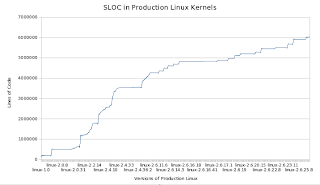Did you know how the kernel development work. I know it very hard to make the kernel working. Most are developers working together. Not like Carnonical aka Ubuntu… They take but never return said by Greg Kroah-Hartman. This one already explained by him on my previous post
Here
You all can view the picture how the kernel development process.
Source: Thanks to Linux Foundation for their statistic
Milestones in Linux Kernel Development History
Linux Foundation
|
Development Cost Milestones |
Production Kernel Version |
Actual Estimated Development Cost (2008 dollars) |
|
$100 million |
Linux 2.0.37 |
$100,482,780 |
|
$200 million |
Linux 2.2.7 |
$200,698,556 |
|
$400 million |
Linux 2.4.2 |
$406,295,326 |
|
$600 million |
Linux 2.4.22 |
$623,138,500 |
|
$800 million |
Linux 2.6.11 |
$815,845,735 |
|
$1.0 billion |
Linux 2.6.19 |
$1,001,218,110 |
|
$1.2 billion |
Linux 2.6.26 |
$1,201,733,129 |
|
SLOC Milestones |
Production Kernel Version |
Actual Source Lines of Code |
|
1 million |
Linux 2.2.1 |
1,167,703 |
|
2 million |
Linux 2.4.0 |
2,210,149 |
|
3 million |
Linux 2.4.20 |
3,093,338 |
|
4 million |
Linux 2.6.6 |
4,008,692 |
|
5 million |
Linux 2.6.19 |
5,111,085 |
|
6 million |
Linux 2.6.26 |
6,015,867 |



Would you be focused on exchanging links?
Only two things are infinite, the universe and human stupidity, and I’m not sure about the former.
Früher war ich sehr erfreut sehr glücklich zu suchen dieser net -site.I gesucht in Ihre dieses hervorragenden Sprachreisen! I definitiv genießen jedes kleine bisschen und es habe Zum einen Blick at neue Slideshows Sie weblog schreiben.
Sie hätten ideal Blog hier ! würden Sie gern machen einige einzuladen zum Thema meiner Blog ?
I love quotations because it is a joy to find thoughts one might have, beautifully expressed with much authority by someone recognized wiser than oneself.
Once again, you want to know who this person is!
Its, goood bllogg.
Hi! Great post! 🙂
Interesting… but where would a band like Tool be established. I’ve heard idiots listen to the music just for the feelings they get, but a well-rounded mind can find solace in the composition…
Music Doesnt makes you dumb, it sometimes makes you horny though
What else can you do, aside from posting this? Can you make it a reality?
Well you obviously didn’t get my point, because I was explaining that the music DOESN’T make you more intelligent, but that some artists require more thought to appreciate, and therefore more intelligent people are on average going to enjoy it. An artist being on the ‘lower end’ doesn’t denote that its listener is less intelligent, it’s just an average. Hence you’ll find the most accessible music closer to the middle. This just means its listener could be anywhere on the scale, but that an average sampling of Switchfoot fans will put their intelligence around 1076. Nevertheless, this study was not very thorough obviously. For example, Jazz is nothing but introspection and thought, and fans of say Miles Davis or Clifford Brown would definitely not be on the lower end of the spectrum. Rather than taking it at face value, you could look at the chart deduce that people with lower scores are more likely to name a genre than list their favorite artists. And of course just listing a genre doesn’t actually mean you know anything about it… so those examples really tell us little about the genre itself.
Speaking of intelligence tests… does the author of this study not realize that “Beethoven” is actually “Classical” music? The results given here are akin to saying that people who enjoy watermelon are much brighter than the people who enjoy large green fruit.
Al Gore did not create the internet, despite popular belief.
I love Lil’ Wayne, Love Jay Z, Hate Phish, Hate the Eagles, and love Bob Dylan and love Ben Folds. Does that make me very stupid, very smart or just not of average intelligence????
I must admit that that is one awesome insight. It surely gives a company the opportunity to get in on the ground floor and really take part in creating something special and tailored to their requirements.
Hrmm that was weird, my comment got eaten. Anyway I wanted to say that it’s decent to realize that somebody else furthermore mentioned that as I had trouble finding the same info elsewhere. That was the first place that told me the answer. Thanks.
well this test isn’t about “bustin a cap” it is about intelligence. it takes little to know intelligence to shoot someone. but in my opinion, it is not the music that makes people dumb but the listeners, being dumb, decide to listen to whatever music is most easily accessible instead of developing a taste for fine music or developed music because they do not have developed ears that can truly develop opinions. and the music will become more about “bustin a cap”.
Its matching social-economic status to music preference. The economic status effects the SAT scores more that the music will.
I stumbled onto whatever I was ready for.
Even on the highest throne in the world, we are still sitting on our ass.
Hier gibt es die neusten und aktuelle Mode Trends von Uhren und Schmuck. Mit vielen Infos und speziellen Angebote. Top Marken von Rofoelo, Watch, Pandora, Fossil und viele mehr.